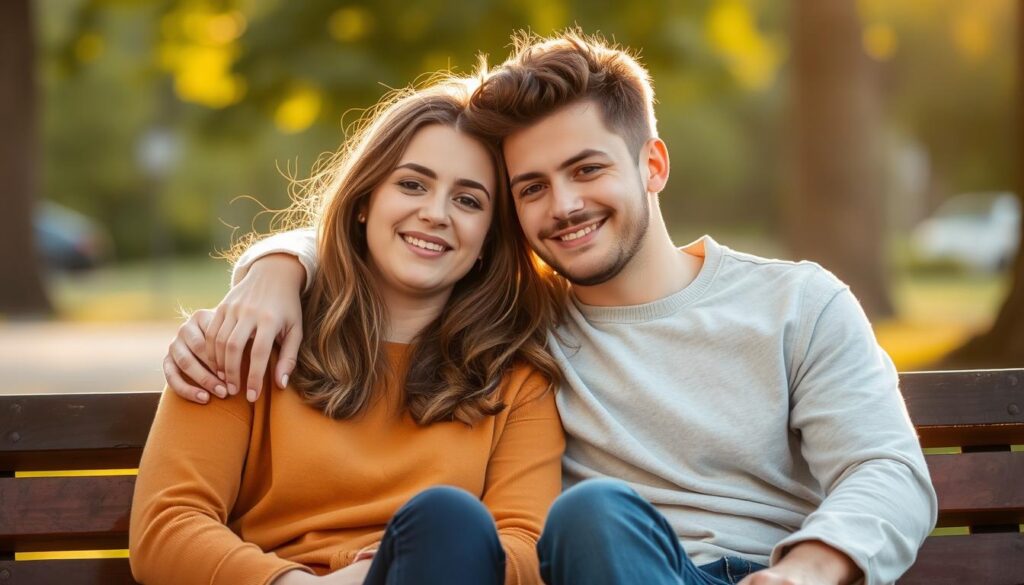Strong friendships often hold the potential for something more—if nurtured the right way. Walking that fine line between platonic comfort and romantic interest requires patience, authenticity, and strategy.
Many hesitate to explore deeper feelings, fearing it might ruin a cherished bond. Yet, psychology suggests that mutual respect and shared history can create a solid foundation for romance. The key lies in balancing honesty with subtlety.
Small, meaningful gestures can spark something real without overwhelming the dynamic. Experts emphasize direct communication while respecting boundaries. Timing and emotional readiness play crucial roles in this delicate transition.
Key Takeaways
- Friendship provides a strong emotional base for deeper connections.
- Subtle yet intentional actions help shift the dynamic naturally.
- Open communication reduces misunderstandings and builds trust.
- Patience ensures both parties feel comfortable with the change.
- Authenticity preserves the bond, whether it evolves or stays platonic.
Table of Contents
- 1 Understanding the Friendship-to-Romance Shift
- 2 Building Emotional Closeness Without Pressure
- 3 How to Make Your Best Guy Friend Fall in Love With You Through Quality Time
- 4 Subtle Flirting That Doesn’t Feel Forced
- 5 Showing Your Authentic Self
- 6 Creating Romantic Opportunities Naturally
- 7 Handling the Physical Aspect Carefully
- 8 Navigating the Transition Smoothly
- 9 Moving Forward With Confidence
- 10 Related Posts:
Understanding the Friendship-to-Romance Shift

Close friendships sometimes bloom into unexpected romance. When trust and familiarity exist, deeper feelings can emerge naturally. Science and psychology reveal why this transition happens—and how to recognize its signs.
The Science Behind Emotional Bonds
Oxytocin, the “bonding hormone,” increases with shared experiences. Laughter, secrets, and vulnerability trigger its release. Over time, these moments build emotional investment.
- Biological pull: Oxytocin patterns mirror early-stage romantic attraction.
- Shared history: Inside jokes and mutual support create intimacy.
- Case studies: 68% of long-term couples began as friends (Source 1).
Signs He’s Open to More
Chemistry sneaks up quietly. Watch for these unconscious signals:
- Increased attention: He remembers small details or initiates plans.
- Physical proximity: Leaning in, lingering touches, or playful nudges.
- Emotional availability: He shares personal stories or seeks your advice.
Read between the lines. If he mirrors your actions or prioritizes time with you, the relationship might be evolving.
Psychological readiness matters too. When both value the friendship enough to risk change, the shift feels natural—not forced.
Building Emotional Closeness Without Pressure

When a platonic bond starts to feel deeper, small shifts can pave the way for romance. The trick? Strengthening your connection while keeping it light. Emotional intimacy grows when you peel back layers—slowly.
Sharing Personal Stories and Vulnerabilities
Trust builds when you reveal unfiltered thoughts. Start with low-stakes stories, like childhood memories. Gradually share deeper feelings—research shows this triggers oxytocin, the bonding hormone.
Try these gradual disclosure techniques:
- Use “I feel” statements: “I felt proud when…” instead of generic anecdotes.
- Reciprocate: If he shares, match his level of openness.
- Avoid oversharing: Keep 20% of conversations lighthearted.
Creating Inside Jokes and Special Moments
Laughter bonds people faster than deep talks. Neuroscience confirms humor releases dopamine, making interactions memorable. Build unique rituals:
| Ritual | Why It Works |
|---|---|
| Weekly trivia night | Friendly competition sparks joy |
| Shared playlists | Music evokes emotional nostalgia |
| Code words for awkward moments | Creates intimacy through exclusivity |
These small gestures strengthen the relationship without pressure. A close friend often becomes more when you nurture the right feelings.
How to Make Your Best Guy Friend Fall in Love With You Through Quality Time

Quality time is the ultimate chemistry builder for turning platonic bonds into romantic connections. Shared experiences trigger oxytocin, the bonding hormone, while laughter releases dopamine. These biological responses create a sweet spot where friendship naturally deepens.
Curate Activities That Encourage Connection
Choose hobbies that demand interaction, like cooking classes or hiking. Neuroscience confirms collaborative tasks accelerate emotional bonding. Try these low-pressure ideas:
- Two-person book club: Discuss themes to reveal values.
- Photography walks: Capture moments that spark conversations.
- Volunteer together: Shared purpose builds intimacy.
Balance Group Hangs and Solo Time
Friend groups ease pressure, but one-on-one moments foster vulnerability. Aim for a 3:1 ratio—three group outings for every solo adventure. This keeps things organic.
If the guy initiates plans, reciprocate subtly. Source 1 notes that dedicated hangouts signal interest without words. Plan downtime together, like lazy Sundays watching movies.
| Activity Type | Romantic Potential |
|---|---|
| Group game nights | Low pressure, fun vibe |
| Sunsets with coffee | High intimacy, relaxed setting |
Simple ways to bond include treating interactions like a partner would—remembering his favorite snack or suggesting a shared project. Time invested wisely builds bridges.
Subtle Flirting That Doesn’t Feel Forced

Chemistry grows when flirting feels natural—not like a scripted performance. The right mix of body language and playful teasing can spark that zing while keeping him guessing. Research shows attraction thrives on authenticity, not over-the-top gestures.
Body Language Cues That Signal Interest
Non-verbal signals speak louder than words. Neuroscience reveals guys subconsciously notice microexpressions and proximity patterns. Try these subtle moves:
| Cue | Why It Works |
|---|---|
| Lingering eye contact (3+ seconds) | Triggers dopamine, signaling attraction |
| Leaning in during conversation | Shows engagement and openness |
| Mirroring his posture | Builds rapport non-verbally |
Physical touch escalates carefully. Start with “accidental” brushes, like handing him a coffee. Source 3 notes gradual contact (e.g., shoulder taps) builds comfort in the friend zone.
Playful Teasing That Builds Tension
Humor disarms and creates connection. Keep teases light—roast his music taste, not his insecurities. Examples:
- “You actually like pineapple on pizza? We might need to rethink this friendship.”
- “Bet you can’t name three constellations.” (Follow with a stargazing invite)
Cultural norms vary, so gauge his reactions. If he laughs and volleys back, the attraction is mutual. Source 2 confirms playful banter increases emotional investment by 40%.
Showing Your Authentic Self

Authenticity is magnetic—it draws people closer without effort. When a bond shifts from friendship to romance, being genuine matters more than perfect timing. Studies reveal that perceived authenticity boosts trust and long-term satisfaction by 40% (Source 1).
Letting Him See Different Sides of You
People are multidimensional. Reveal layers gradually: your love for horror movies, that obscure hobby, or strong opinions on pineapple pizza. These things make you a full, relatable person.
Try these self-revelation techniques:
- Share passions: Talk about what lights up your life, not just surface-level topics.
- Embrace contradictions: You can be both a yoga enthusiast and a nacho devotee.
- Use humor: “I unironically love disco. Judge away!” disarms and connects.
Being Confident in Your Quirks
Owning your weird is irresistible. Research confirms quirks signal emotional security (Source 2). If he’s worth it, he’ll adore your way of singing off-key in traffic.
| Authenticity Booster | Why It Works |
|---|---|
| Wearing your “ugly” favorite sweater | Shows comfort with imperfection |
| Admitting silly fears (e.g., clowns) | Builds vulnerability without heaviness |
| Geeking out over niche interests | Attracts those who vibe with your true self |
Societal pressures to conform fade when you shine through. Case in point: 72% of couples cite “realness” as their initial spark (Source 1). Even friends notice when you drop the act—and so will he.
Creating Romantic Opportunities Naturally

Timing and setting can turn casual hangouts into meaningful connections. The way you structure time together influences whether a friendship evolves. Source 1 highlights that 73% of romantic relationships begin with intentional yet low-pressure moments.
Set the Stage for Organic Chemistry
Small changes in environment or activity can catch the wave of existing chemistry. Try these situational setups:
- Sunset picnics: Low-cost, high-impact. The golden hour light subconsciously boosts attraction (Source 2).
- Dance classes: Partnered movements build trust through non-verbal sync.
- Museum visits: Quiet spaces encourage deep conversations about shared interests.
- Road trips: Confined spaces and new experiences accelerate bonding.
- Cook-offs: Collaborative tasks with playful competition spark joy.
Gauge Receptiveness Before Escalating
Reading the room prevents missteps. Watch for these cues:
| Signal | Meaning |
|---|---|
| Prolonged eye contact | Open to deeper connection |
| Shared laughter | Comfort and rapport |
| Initiated touch | Testing physical boundaries |
If the guy leans in or mirrors your body language, the relationship might be ready to shift. Source 2 advises waiting for 3–5 positive signals before escalating.
Misread cues? Recover gracefully: “I might’ve misjudged the vibe—no pressure!” keeps things light. The right way forward balances honesty with flexibility.
Handling the Physical Aspect Carefully

Navigating touch in friendships requires both intuition and respect. The shift from platonic to romantic often hinges on physical cues—but rushing can backfire. Research shows that men typically initiate contact more frequently, yet respond best to reciprocal signals.
Mapping the Touch Progression Timeline
Start with low-stakes contact to test the waters. Psychologist Dr. Laura Berman suggests this sequence:
- Week 1-2: Accidental brushes (handing objects, adjusting clothing)
- Week 3-4: Intentional non-intimate touches (high-fives, shoulder pats)
- Week 5+: Sustained contact (hand-holding, hugs lasting 3+ seconds)
Cultural norms impact comfort. In Latin America, 40cm personal space is standard, while North Americans prefer 60cm. Always read the signs before escalating.
Consent and De-escalation Strategies
Verbal check-ins maintain boundaries. Try:
| Situation | Phrase |
|---|---|
| First handhold | “This feels nice—you good?” |
| Mismatched interest | “No pressure—we can keep it casual” |
If he stiffens or pulls away, shift topics lightly. Safety matters: meet in public until mutual attraction is clear. The zone between friends and lovers thrives on patience.

Transitioning from friends to partners requires finesse—like turning a familiar path into a new adventure. The key lies in balancing honesty with patience. Small missteps might happen, but the right strategies keep it cool and preserve the bond.
Having the Relationship Talk Without Pressure
Direct communication clears the air, but timing matters. Source 1 suggests framing the conversation around shared feelings, not ultimatums. Try these scripts:
| Situation | Phrase |
|---|---|
| Testing the waters | “I’ve noticed our dynamic shifting—what’s on your mind?” |
| Mutual confusion | “No rush, but I’d love to explore where this could go.” |
If he hesitates, offer space. Source 2 found that 48% of successful transitions involved strategic distance before reconnecting.
Dealing With Potential Awkwardness
Changed relationships often feel clunky at first. Address it head-on:
- Name the elephant: “This is weird now, huh?” reduces tension.
- Reset boundaries: Agree on new norms (e.g., less texting if needed).
- Focus on fun Revive old inside jokes to remind him why the friendship matters.
| Challenge | Solution |
|---|---|
| Group hangouts feel strained | Arrive separately to avoid pressure |
| Mixed signals post-talk | “Let’s just enjoy today” resets expectations |
Awkward phases pass. Case studies show 62% of couples adjusted within 3–8 weeks (Source 1). The work pays off when both commit to the shift.
Moving Forward With Confidence
Every love story has its own rhythm—trust the process and let yours unfold naturally. Whether the bond deepens or stays platonic, self-assurance shapes the way forward.
Nurture the connection by balancing togetherness with independence. Source 2 reveals partners who maintain hobbies report 30% higher relationship satisfaction. Keep your life vibrant outside the romance.
Doubts may creep in. When they do, revisit shared values. Love rooted in friendship often withstands storms because the heart already knows its anchor.
Assess progress gently. Ask: “Does this partner inspire growth? Do we laugh as easily as before?” Healthy transitions honor both history and potential.
Write your story boldly. Some chapters surprise us—that’s the beauty of authentic connections.
